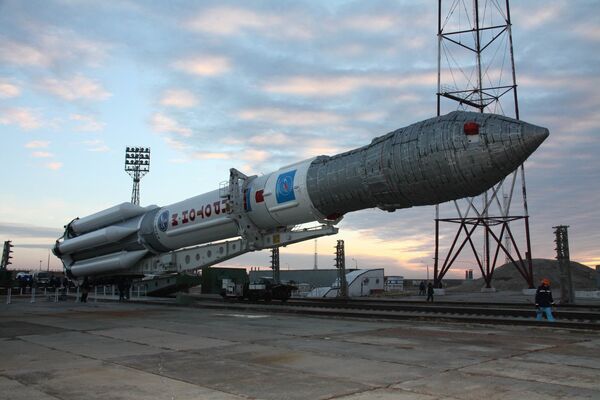MOSCOW, May 16 (RIA Novosti) — Russia’s Proton-M carrier rocket suffered an unknown failure and was lost shortly after taking off from Baikonur space center in Kazakhstan early on Friday, failing to send what would have been the nation's most powerful and high-tech satellite, Express-AM4R, into the orbit.
The heavy-class rocket carrier Proton-M is used to place unmanned space vehicles into the Earth's orbit and then into space.
Proton-M stands at the basis of Russian Federal Space Program in the heavy rocket carrier class. The carries plays a crucial role in the development of Glonass navigation satellite system, in Express satellite launches, which provide satellite connection for all Russian regions. It is also used for spacecraft placement by the Russian Defense Ministry.
It was developed by the Khrunichev State Research and Production Space Center and has been used for the placement of Russian and foreign commercial spacecraft’s since April 2001.
Proton-M is a modern version of Proton-K carrier, with a more efficient energy use, higher ecological characteristics and is easier in use. It has double the capacity of the previous carrier due to larger nose fairing, reaching 5 meters in diameter, which also allow placing a range of prospective boosters.
One of the major changes was the replacement of the outdated 1960s control system with a new one based on the onboard digital computer complex.
The new control system allowed for a more efficient use of onboard fuel, which also minimalized harmful remains. It also provided for a space maneuver in the active stage of the flight, which increased the range of possible support orbit inclinations, as well as near real-time entry or change of mission. The change also improved the rocket's weight characteristics.
Since it was first implemented, the rocket has undergone several modernization stages. After the first one in 2004, the carrier was able to place a 5.6-ton Intelsat-10 heavy spacecraft into the geosynchronous transfer orbit. The second modernization stage was completed in 2007 with the launch of a 6-ton DirecTV-10. The third stage took place in 2008, and the fourth is currently underway.
Proton-M technical characteristics:
Composition: 3 stages
Launch weight: 702 tons
Types and number of engines:
First stage - liquid engine RD-275 (6)
Second stage - liquid engine RD-0210 (3) and RD-0211 (1)
Third stage - liquid engine RD-0213 (1) - cruise engine; liquid engine RD-0214 (1) - control engine.
Diameter/Length of the nose fairing (in meters):
4.35/11.6 (RB Briz-M (Breeze M))
4.35/15.255 (RB Briz-M)
5.10/16.371 (RB Briz-M)
5.10/19.65 (oxygen/hydrogen upper stage)
4.35/12.65 (low-orbit module).




